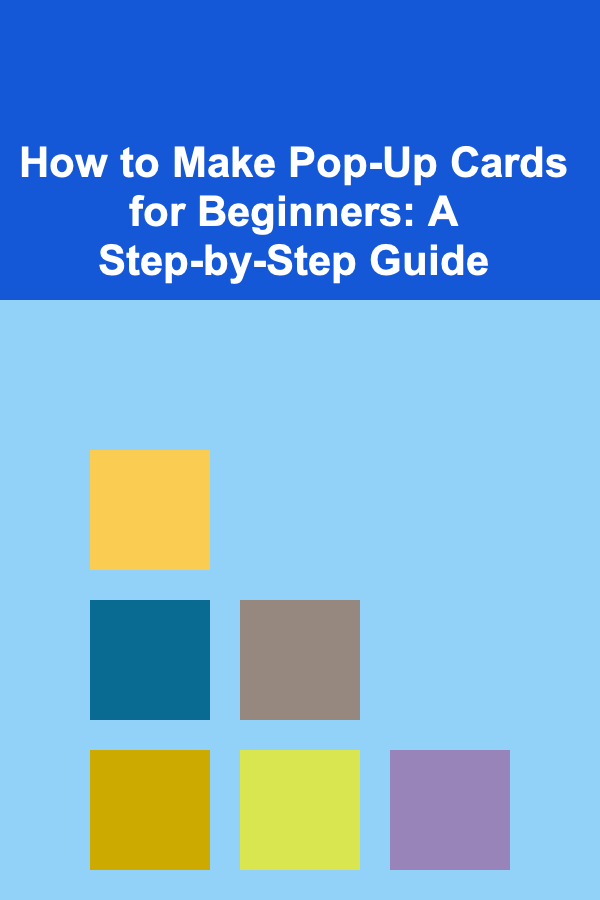
How to Make Pop-Up Cards for Beginners: A Step-by-Step Guide
ebook include PDF & Audio bundle (Micro Guide)
$12.99$6.99
Limited Time Offer! Order within the next:

Pop-up cards have a magical way of turning a simple greeting card into an interactive experience. Whether you're making them for a special occasion like a birthday, holiday, or simply as a thoughtful gift, creating pop-up cards allows you to add a personal and artistic touch to your greetings. In this guide, we'll walk you through everything you need to know to make your own pop-up cards, even if you're a beginner. We'll cover the materials you'll need, the basic techniques, and provide step-by-step instructions to help you create a beautiful pop-up card.
Materials You'll Need
Before you start creating your pop-up card, gather the following materials:
- Cardstock or Construction Paper -- This will be the base of your pop-up card. Choose a sturdy paper so that it can support the pop-up mechanism and hold up to being opened and closed multiple times.
- Scissors -- For cutting your paper into the desired shapes and sizes.
- Glue -- A strong adhesive like craft glue or glue sticks. Hot glue can also be useful for securing intricate pop-up designs.
- Markers, Stamps, or Colored Pencils -- For decorating the outside and inside of your card.
- Ruler -- To measure and create clean, straight lines.
- Pencil -- For sketching out your design before cutting and gluing.
- Bone Folder or Creasing Tool (optional) -- To make precise folds.
- Pop-Up Mechanism Templates -- For beginners, using templates or pre-made designs can simplify the process. You can find many online or even create your own.
Once you've gathered these materials, you're ready to begin making your first pop-up card!
Step-by-Step Guide to Making a Basic Pop-Up Card
Let's start with a simple pop-up design that will teach you the basic principles of how pop-up cards work. We'll go over a simple design involving a basic "box" pop-up shape.
Step 1: Choose Your Card Size and Fold the Base
Start by choosing the size of your card. A common size for pop-up cards is 5" x 7" (approximately 12.7 cm x 17.8 cm). To make the card, follow these steps:
- Cut a piece of cardstock or construction paper to your desired size.
- Fold the card in half along the long side to form the base of your card. Use a bone folder or a ruler to create a clean, crisp fold.
Step 2: Plan the Pop-Up Design
Next, decide on the shape or object you'd like to pop up. For beginners, a simple shape like a box or a basic geometric design works well. The pop-up element will be created using cuts and folds inside the card.
- Draw the Design on a Piece of Scrap Paper -- Sketch the basic shape you want to pop up inside your card. If you're creating a box, for example, you can draw a simple rectangle. If you're unsure about the pop-up mechanism, you can search for templates online or use pre-made designs.
- Plan the Placement -- Think about where you want the pop-up to appear when the card is opened. Typically, pop-ups are positioned toward the center or slightly off-center to create a surprise element.
Step 3: Create the Pop-Up Mechanism
There are many different ways to create pop-up mechanisms. Let's start with a simple box pop-up mechanism:
- Mark the Folds and Cuts -- Open the folded card, and lightly mark two vertical lines on the inside center of the card where the pop-up will appear. These marks should be parallel and about 2 to 3 inches (5 to 7.5 cm) apart, depending on the size of your pop-up.
- Cut and Fold the Flaps -- Cut along the lines you've marked. Once you've made the cuts, fold the two flaps inward, forming a small rectangular shape that will pop out when the card is opened. Be sure the folds are crisp so the mechanism works smoothly.
Step 4: Add the Pop-Up Element
Once the pop-up mechanism is set up, it's time to add the pop-up object. Let's use a box as an example:
- Cut a Rectangle for the Box -- Using your scrap paper, cut a small rectangle that will fit the pop-up area you created. You can make the box as big or small as you want, depending on the size of your card.
- Make the Box Shape -- Fold the rectangle in half along its length to form the base of the box. Then, cut slits in the sides of the rectangle, just slightly longer than the width of the base, and fold the flaps inward to create the walls of the box.
- Attach the Box to the Pop-Up Mechanism -- Glue the base of the box to the pop-up mechanism inside the card. Make sure to glue only the base and the bottom of the box, leaving the walls of the box free to "pop" when the card is opened. The box should fold flat when the card is closed and stand up when the card is opened.
Step 5: Test the Mechanism
Before you proceed with decorating the card, it's important to test the pop-up mechanism. Gently open and close the card to ensure the box pops up correctly. If the box doesn't pop up, check your cuts and folds, making sure everything is aligned properly.
Step 6: Decorate the Card
Now that the pop-up mechanism is in place, it's time to make your card visually appealing! There are endless possibilities for decorating your card:
- Add Background Decorations -- You can add colorful background designs to the card, such as patterns, images, or textures. Use markers, colored pencils, or stamps to create your design.
- Decorate the Pop-Up Element -- Add details to the pop-up element, such as drawing patterns on the box, adding small embellishments like ribbons or glitter, or even attaching small items like paper flowers or cut-out images.
- Write a Message -- Don't forget to write a message on the front or inside of the card. A personalized note can make your card feel even more special.
Step 7: Final Adjustments
Once you've completed the decoration, take a moment to carefully inspect your pop-up card. Make sure all folds are sharp, the glue has dried, and the card opens and closes smoothly. If the card feels too bulky or uneven, adjust the decorations accordingly.
Advanced Techniques for Creating Pop-Up Cards
Once you're comfortable with the basic pop-up card, you can start experimenting with more advanced techniques. Below are some ideas for expanding your skills and creating more intricate designs.
1. Layered Pop-Ups
Layered pop-up cards use multiple pop-up elements stacked on top of each other to create depth and dimension. Each layer is typically attached to a separate fold or flap, so when the card is opened, the layers pop up sequentially.
To create layered pop-ups, simply repeat the steps for the basic pop-up mechanism, but make sure each layer is glued to a different fold or flap inside the card. Layering multiple pop-up elements creates a more dynamic, 3D effect.
2. Interactive Pop-Up Mechanisms
For a more interactive pop-up experience, you can add elements that move. For example, you can create pop-up animals or characters that "wave" or "jump" when the card is opened. To create moving elements, attach them to the pop-up base using brads (paper fasteners) or small pieces of string so that they can pivot or swing.
3. Pop-Up Cards with Sliding Elements
Some pop-up cards have sliding mechanisms where elements move horizontally or vertically as the card opens. You can create sliding elements by cutting slits in the card and attaching a tab or small image that slides out as the card opens. This type of card offers an even more dynamic visual effect.
Conclusion
Creating pop-up cards is a wonderful way to personalize your greetings and showcase your creativity. As a beginner, starting with a simple box pop-up card will give you the foundational skills to create more intricate designs in the future. By experimenting with different materials, techniques, and designs, you can make pop-up cards for any occasion---whether it's a birthday, holiday, or just because.
As you continue to practice, you'll develop your own style and learn new techniques that will allow you to create even more stunning pop-up cards. So gather your materials, follow the steps outlined in this guide, and let your imagination run wild!
Reading More From Our Other Websites
- [Home Budget Decorating 101] How to Use Peel-and-Stick Wallpaper to Add Character to Any Room Without Breaking the Bank
- [Gardening 101] How to Create a Magical Fairy Garden in Your Backyard
- [Biking 101] What Makes the Best Bikes? Features You Should Look For
- [Stamp Making Tip 101] Mix, Match, and Layer: Using DIY Stamps to Elevate Your Daily Journaling Practice
- [Organization Tip 101] How to Create a Vision Board for Mindful Goals
- [Stamp Making Tip 101] Elevate Your Stationery: Integrating Hand‑Carved Stamps into Modern Calligraphic Projects
- [Personal Financial Planning 101] How to Choose the Right Investment Strategy for Your Goals
- [Home Staging 101] How to Stage a Rental Property for Short-Term Tenants
- [Mindful Eating Tip 101] From Street Food to Fine Dining: A Mindful Traveler's Guide to Eating Well Abroad
- [Personal Care Tips 101] How to Layer Aftershave with Beard Oil for Maximum Skin Benefits

How to Manage Cleaning Tasks with Kids at Home
Read More
How to Compare Credit Card Offers
Read More
How to Track Student Progress in Your Ski Instructor Planner
Read More
10 Tips for Houseguest Preparation: Pet Edition
Read More
10 Tips for Protecting Your Colored Bookmarks
Read More
10 Tips for Feng Shuiing Your Digital Space
Read MoreOther Products

How to Manage Cleaning Tasks with Kids at Home
Read More
How to Compare Credit Card Offers
Read More
How to Track Student Progress in Your Ski Instructor Planner
Read More
10 Tips for Houseguest Preparation: Pet Edition
Read More
10 Tips for Protecting Your Colored Bookmarks
Read More